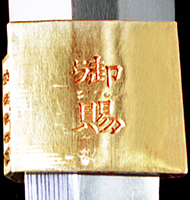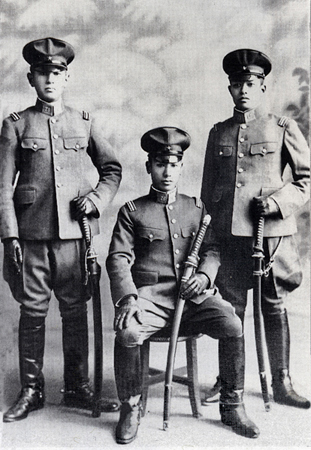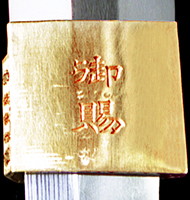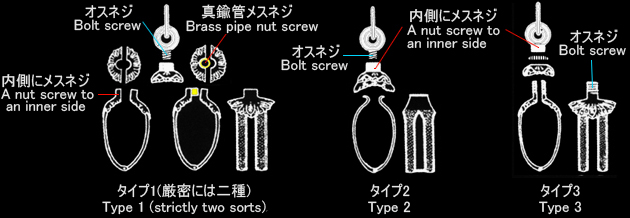Type 94 Guntō�@(1) 0
Army commissioned officers Shin-Guntō
1934
Common name: Type 94 Guntō
In 1925, the Shōwa period had begun, and the tendency of
nationalism was increasing gradually in Japan. Against the
background of such a trend, the Guntō which has been saber form since
national army foundation came to receive the
influence.
In 1932, the army revised the hilt of the Type 32 Guntō for a
noncommissioned officer and privates in Japanese sword
form (Type 32 Guntō Kai). This was Japanese sword form only the
hilt, and the scabbard was a saber form as usual.
On February 15, 1934, the army proclaimed the mounting of the new
Guntō which made the Japanese Tachi the model as
Guntō for officers. This is the army formality Guntō (common-name Type
94) of the 1934 establishment.
It became March 10 enforcement of the Army Day.
The mounting was what arranged the Tachi from ancient times in a
modern style, and was a perfect Type-Tachi Guntō with
two suspension mounts.
The 26th regiment
of the 40th brigade field gun of the 20th army
division (Seoul) infantry.
From the left, each second lieutenant of the Yasumura Shimizu,
Yasuji Mitsugu, and the Yatao Nakamura.
�@
The 50th term of a military academy. Commemoration photography of
second lieutenant appointment in 1937.
Three officers are wearing 1930 (the Sho-5 type military uniform,
a stand-up collar).
Therefore, in order to hang on the hip girdle of an informal
sword, the Guntō has removed the second Suspension mount
of the Type 94 Guntō. The left officer attaches the leather cover for
field battles to the scabbard. Two left persons
are wearing a Czechoslovakia style an army cap. Fancy youth officers of
those days were fond, and put on this.
Type 94 royal gift Guntō "Yasunori"
Army
Guntō of a Imperial gift:
Yasunori�AModern-tō (Yasukuni-tō), ( Blade length: 67.0�p,
Curvature: 1.6�p ), Iron scabbard: Blackish brown gloss coating, Two
suspension mount,
Spring-clip, Openwork guard, With the tassel for field officers,
Overall length: 100.5�p.
�@�@�@�@�@�@�@�@�@�@�@�@�@�@�@�@�@�@�@�@�@�@�@�@�@�@�@�@�@�@�@�@�@�@�@�@

A mounting is as adopted-types regulation. A guard is golden. A
scabbard, metal fittings, and a Tsuka-ito are blackish brown. Round
string Knot loop. It is a near condition intact.

The conditions where the second Suspension mount of an
attachment-and-detachment type was removed

|
�@Inscribed Jpanese 2 Kanji characters "ONSHI" on the blade
collar(Habaki)
�@ means the Imperial gift. |
 |
|
|
�@Mei: Yasunori Tsutsushinde Tsukuru
�@Yasukuni swordsmith: Real-name is Kenzō Kotani. He was
born to 1909 in Hiroshima Prefecture.
�@He joined the "Japanese sword forging association " in 1933. He can
give the swordsmith Mei of "Yasunori" from a
�@Hayashi army minister in 1935.
�@He wins a chairman prize at the Guntō exhibition of the second army.
�@He established forging workshop also at the house and started the
sword making in 1938.
�@The Mei stamped with "Takenori"
Three
sorts of second suspension
mounts of an attachment-and-detachment type.
1
Type 94 Guntō
table of contents�@ 
�@�@�@�@�@The Guntō of a royal gift
(Yasuhiro)�@�@Mumei Kotō
& Rayskin binding wooden scabbard
�@�@�@�@�@�@Army Type 94 new Guntō
establishment
January 7, 2014�@
To
the top of a page ��












